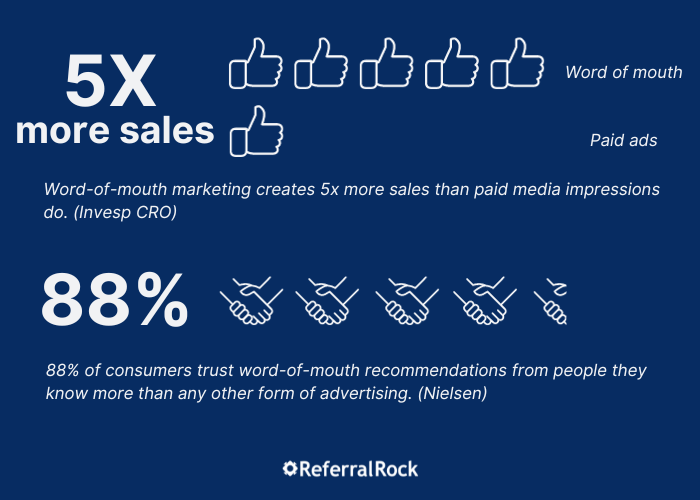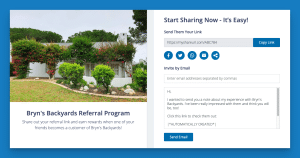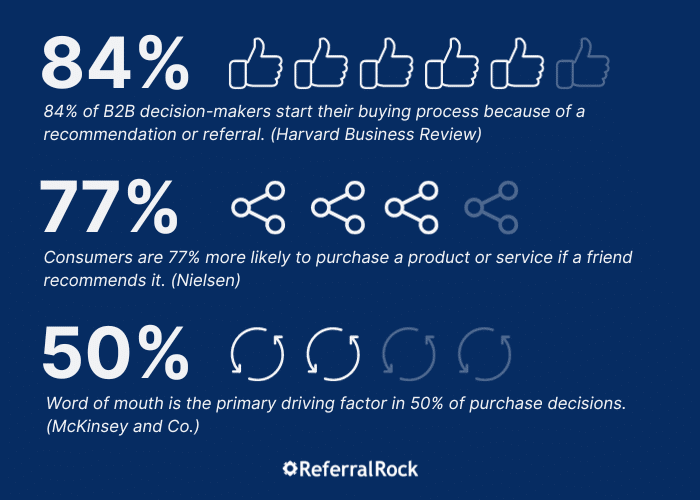Looking for new ways to grow your customer base? Don’t forget about wowing the customers you already have to generate more word-of-mouth marketing.
This excitement to share is what drives word-of-mouth marketing (also called WOM marketing, WOMM, or word-of-mouth advertising). And this sharing leads to new customers, because the people who hear your customers’ recommendations highly trust the word of their peers.
Ready for a word-of-mouth marketing strategy to be your secret weapon for growth? Although this type of marketing depends on your customers and fans, it’s not out of your control. Read on to find out the top 7 ways you can harness word-of-mouth marketing tactics to scale your business.
What is word-of-mouth marketing?
Word-of-mouth marketing (WOM marketing) happens when people talk to others about your brand, products, or services, in person or online. It also includes any actions your business takes to encourage people to share their experiences with your brand and recommend it to others. Common forms of word-of-mouth marketing are reviews, social media shares, and referrals from friends. This results in free (or nearly free!) advertising for your brand.
The power of word-of-mouth marketing comes from its high level of trust. Word-of-mouth recommendations usually come from friends, family members, and others within someone’s circle. When someone sees a friend or family member raving about a particular brand, they’re much more likely to buy because peer recommendations are seen as especially valuable
According to a Nielsen report, 92% of people trust word-of-mouth referrals from people they know over all other forms of advertising.
Plus, thanks to social media, when someone shares it can have broad reach in minutes. And word of mouth doesn’t just stop after one interaction – it has compounding interest. One person will tell another if they have a great experience, and another, and so on. With every share, repost, or retweet, word-of-mouth marketing carries the potential for exponential growth.
All this happens at a very low cost to your business – often, for free.
7 ways to boost customer growth with word-of-mouth marketing [+ examples]
Now that you’ve seen the importance (and potential impact!) of word-of-mouth marketing, how can you drive more of it for your business?
Based on our experience in the referral marketing space, these are the seven best ways to create reliable word-of-mouth for your business.
1. Deliver an above-and-beyond experience
Before you can drive reliable word of mouth from your customers and other fans, you need to create a reason for them to rave about your business.
Usually, word of mouth is prompted by an above-and-beyond experience someone has with your brand. Think about the last time you ate an amazing dinner out, experienced great service, or tried a software program that easily solved one of your company’s problems. You probably couldn’t help but share this outstanding experience.
The key to making your brand worth talking about is providing value. Whether that means solving a problem with your product or delivering unparalleled customer service, the value your brand provides will make a customer both stick with you and share your brand with others.
If you can offer tons of value, you’re much more likely to earn a positive customer review, promote brand loyalty, and maximize your word of mouth.
Pro tip: Remember that the best way to provide value is to deliver a unique experience. What sets you apart from your competitors?
Do you…
- Market differently than others in your space?
- Meet a need that no one else does with your product/service, like Browndages first did with their bandages and wraps made for darker skin?
- Solve a specific problem (even one that people didn’t realize they needed solving), like Omsom does with “starter” packets that include all the flavors needed to make authentic Asian dishes?
- Deliver above-and-beyond customer experience that competitors can’t match, like Zappos has built a reputation for?
- Provide a uniquely high-quality product at a lower pricing point than competitors?
Know, deliver on, and emphasize this unique selling point, and watch the word of mouth roll in.
After you’ve created this reason to share, make the act of sharing itself easy as well. Whether you email them a one-click access link to your referral program that lets them start sharing right away, or make it super simple for them to leave a review, create a way for your customers to start spreading word of mouth in just a few clicks or taps.
2. Start a customer referral program
Now that customers have a reason to share, how do you encourage them to share repeatedly? A referral program is one of the best ways to generate reliable word of mouth for your brand, whether you’re a B2B B2C, or hybrid business.
“Are you getting word-of-mouth already? That means that you’re doing all the core business activities that make you refer-able.
“If you’re doing a good job as a company and you provide a great service or product, you’re already hopefully getting some organic word of mouth, which is the seed for a healthy referral program. Ask yourself – can I now lean into that word of mouth and get more referrals by asking?”
– Josh Ho, CEO of Referral Rock
Referral programs incentivize your customers to recommend your brand to their friends, family, and colleagues in exchange for rewards. Whenever someone refers a friend to your brand, and that friend makes their first purchase, you reward the referring customer as thanks for bringing in the new business.
By offering repeated rewards for referrals, a referral program gets your customers to keep sharing your brand. You can also offer rewards to the referred friends, to encourage them to purchase your products or services – and possibly start referring their own peers, in a continuous cycle of word of mouth.
But just setting up a referral program and then leaving it alone won’t be enough to create repeated word of mouth.
To achieve the most success with your program, you’ll need to:
- Choose incentives that customers love, so they want to share
- Align the incentives with your sales process – if you’re a B2B, you may want to reward for both leads and sales
- Make sharing super easy for customers (ideally, with no signups or logins)
- Promote your program well, so it’s at the top of customers’ minds after they have a great experience
- Have a reliable way to keep track of all the referrals each customer makes
- Keep program members in the loop about their referrals
- Reward customers in a timely manner, so they’re motivated to keep referring
These tasks can be tough to carry out with a manual program, so it’s best to enlist the help of referral program software to automate your program. Referral software lets you build a streamlined referral program that’s easy for customers to use – each advocate can quickly access their own unique referral link and send their friends directly to your business.
Plus, software can make it easy to promote your referral program, so customers remember to take advantage of the program’s benefits. And once your customers start referring, software ties every referral back to the customer who made it, and sends out rewards for those referrals right when customers earn them.
An added bonus? Referral software can help build even more trust, by letting your customers send a personalized message to the friends they refer. To make things easier, you can pre-draft the message on customers’ behalf so customers can send it right away, and then let customers add or change that message as they wish.
Pro tip: Pick software that lets you target referred customers with personalized promotions, to encourage them to join the program themselves and share with their own friends!
3. Ask for reviews
Reviews and testimonials, like referrals, are an especially powerful form of word-of-mouth marketing, as they’re highly trusted. 72% of potential customers will only make a purchase after reading positive reviews, and nearly half of customers trust online reviews as much as they trust personal product recommendations. In addition, 92% of B2B buyers are more likely to make a purchase after reading a trusted review.
Good reviews help build your brand’s social proof and boost your online reputation – both terrific ways to gain exposure and get even more people talking about you.
Reviews might seem unpredictable, but there are ways to encourage more (and better) reviews without gaming the system. The key is to ask the right people for reviews, and strategically time your ask. Directly ask for reviews when customers are happiest, such as:
- Right after they’ve purchased and received a product
- After they’ve given positive feedback
- When they reach the “aha” moment of getting value out of your product
- After they’ve made a stellar social media post
- After they refer a friend
You can also use indirect “asks” that make you more easily reviewable. For instance, you could:
- Mention that you have a page on a review site (“We’re on Capterra!”) without directly asking for a review
- Place a button on your website that links to a review site
- Add a review call-to-action (with your review site link) in a newsletter
For more tips on getting the most out of reviews, check out our comprehensive guide on how to ask for reviews.
4. Recruit affiliates, influencers, or ambassadors
If people hear someone talking about how good your product is, this word of mouth will make them more likely to try the product.
But when they see someone using your product in their everyday life – especially an expert in a field, or a blogger or social creator with lots of authority among an audience – this social proof gives word-of-mouth a bigger boost. That’s why it’s advantageous to recruit affiliates, influencers, or ambassadors to promote your product or service.
Ambassadors’ and influencers’ posts using your product, and affiliates’ product reviews on blogs and social networks, show off your product and further inspire people to try it for themselves. But there are some key differences between each type of advocate, so pick what fits your needs depending on your business.
- Affiliates will send customers to your website with a trackable link. Every time someone uses that affiliate link to make a purchase, the affiliate will earn a cash commission.
- Influencers promote your products in the short term, and earn cash for every short campaign. A campaign usually consists of one to three posts on social media.
- Ambassadors promote your products in the long-term, by repeatedly posting about you or including your business on their website. You could reward them with cash, store credits, or free products as thanks. You have flexibility to reward ambassadors how and when you choose.
While influencers are more common in the world of ecommerce and physical products, there’s a growing trend of B2B marketing influencers. And affiliates are quite common in the B2B space, especially in the SaaS industry.
5. Encourage social sharing and user-generated content
Paid promoters aren’t the only ones who can create powerful word-of-mouth on social media platforms. The more connected you are to your followers, the more likely they will become true fans and supporters.
And what do true fans usually do? Share your brand with others and increase word of mouth in new markets you may not have been able to reach otherwise. If you get lots of your fans to start talking about you at once, and create user-generated content (UGC), that has the potential to reach thousands or even millions of eyes.
How do you encourage your fans to keep creating UGC? Here are some of our top tips:
- Create branded hashtags for fans to use when they share
- Comment on UGC posts you love, to build connections and thank customers for sharing
- Feature the best posts about your brand on your own channels (your social accounts and your website), with the creators’ permission
- Run contests and giveaways, where the creators of the best branded UGC earn valuable prizes or unique features (as Apple did with their #shotoniPhone campaign)
6. Create knockout content
Which digital marketing content would appeal best to your target audience – an interactive contest, a behind-the-scenes video, or something else? By continuing to give your audience what it wants through content marketing, you’re able to add to your social currency and generate word of mouth.
Social currency is all about reputation. People share what they think will make them look good in front of others, because every share puts their reputation on the line. They’ll only “spend” their social currency on your brand, and spread the word about you, if they think it will give their reputation a boost.
Appealing to emotions is another great way to create content that’s worth sharing. Whether you create something happy, sad, funny, or otherwise, people instinctively want to share it with others if they are moved by it.
And if your brand has a unique personality, this can also stir up emotions. Use your personality for emotional appeal, in a way that stands out from the crowd, and customers won’t be able to stop talking. This works especially well if you’re appealing to humor. Think of how Wendy’s went viral thanks to their signature snarky, humorous tweets.
7. Tell a story worth sharing
Writing your brand story goes hand in hand with creating shareable content, and is another reliable way to generate word-of-mouth marketing. Your story could focus on your product, company culture, or point of view, as long as it’s something that your audience will be compelled to share – and as long as it genuinely reflects your brand and its values.
Creating a compelling story goes hand in hand with offering value and appealing to emotions. If customers love the “why” behind what you do – your mission and values – and that “why” is packaged in a story that’s moving and easy to tell, customers will share your story with others.
One example is 4Ocean’s story: they pull plastic from the ocean daily to help marine life, and then recycle much of that plastic into bracelets and other products. That story is the main reason 4Ocean’s bracelets have become so well-known.
Even if you’re a small business (and not a big brand), you can find a story worth sharing — we love this marketing exercise as a way to get started.
Word-of-mouth marketing FAQ
Still have questions about word-of-mouth marketing? We’re here to help.
How effective is word of mouth marketing?
These word-of-mouth marketing statistics further prove how successful word-of-mouth marketing can be:
- 83% of Americans say that word-of-mouth recommendations from people they know make them more likely to purchase a given product or service.
- When it comes to products they have purchased, 74% of people identified word of mouth as a key factor in their purchase decision.
- Marketers rate the quality of leads brought in by word of mouth as a 4.28 out of 5.
What is amplified word of mouth vs. organic word of mouth?
Word-of-mouth marketing can be divided into two main types or categories: amplified word of mouth and organic word of mouth.
Amplified word-of-mouth marketing is directly encouraged by your business via a marketing campaign. Within the campaign, businesses will usually use some sort of reward to motivate this word of mouth. Amplified word of mouth strategies are also easy to track, since they are tied to a campaign.
Examples of amplified word-of-mouth marketing campaigns include:
- Referral programs
- Affiliate programs
- Brand ambassador programs
- Influencer marketing campaigns
- Other customer endorsements you encourage with rewards
- Other campaigns and contests to encourage social media sharing
In contrast, organic word-of-mouth marketing occurs when someone recommends your brand naturally and without direct prompting from your business.
While it’s much harder to motivate and track, this type of word of mouth isn’t fully out of your control.
It’s usually triggered by an event experienced by the customer. Whether that’s amazing customer service or a free gift with purchase, triggers set your brand apart from the competition and keep you top of mind. Plus, they make for great talking points and organic word of mouth.
Some organic word-of-mouth marketing examples include:
- Spontaneous social media sharing (user-generated content)
- Reviews and comments from satisfied customers
- Natural sharing of a product through any type of conversation
- “Dark social” sharing in DMs and private emails, which doesn’t have a tracking tag
Learn more about specific types of word-of-mouth marketing.
How is WOMM different from referral marketing?
Word-of-mouth marketing is all about getting people talking about your brand or business. It looks for the best ways to promote sharing, often through general consumer interest or unique content. Depending on the types you choose to focus on, though, you may have difficulty tracking and controlling it.
Referral marketing is a segment of word-of-mouth marketing. It’s common for word of mouth to occur naturally in the process of referring others. But at its core, referral marketing is a proactive way to gain new customers, focused on key targets and specific results.
Referrals happen when someone who uses or knows your brand recommends it to others in their network, usually friends, family members, or colleagues. Since they’re sharing your brand with others, they’re generating word of mouth. But this recommendation is direct and purposeful, not just casually mentioned.
Referral marketing also allows you to monitor your conversions, engagement, and other metrics.
How should you combine referrals with other word-of-mouth marketing?
With a formal referral program, businesses can incentivize customer sharing and organize their entire referral process. The right referral software can also generate automatic referral links and track each step of the process, so you know exactly where referrals are coming from.
Using referral marketing with other word of mouth strategies maximizes brand awareness and increases the odds of creating a viral sharing effect. By integrating diverse types of word-of-mouth marketing into your overall marketing strategy, you increase the odds of achieving success.
To learn more about referral marketing, check out our referral marketing guide or learn essential referral program tips.
What’s the difference between “buzz marketing,” “viral marketing,” and WOM?
Buzz marketing and viral marketing are techniques that generate word of mouth, but they generally generate it in short bursts rather than creating a longer-term sharing engine.
- Buzz marketing is designed to generate viral “buzz” or excitement and conversations around a product, business, or service. It builds viral growth around certain products or campaigns, usually using attention-grabbing techniques (i.e., videos, memes) and generating online buzz. Often, brands use social media marketing for their buzz marketing campaign.
- Viral marketing relies on one’s existing network to spread information from person to person in a rapid manner. This often occurs online or using social media, with content so compelling that people can’t help but send it with others.
Start a referral program to drive more word-of-mouth business
Don’t sleep on word-of-mouth marketing. Recommendations and referrals are powerful ways to generate new business! People trust the word of their family and friends, making them more likely to purchase from you when their peers recommend your products.
Ready to create consistent word-of-mouth marketing? Rewarding advocates for their referrals is key, and referral software can make running a refer-a-friend program much easier.
With Referral Rock, you can:
- Give customers instant links to access their referral program without needing to log in
- Set up customized rewards to best appeal your customers
- Create a tiered referral program, where members can earn higher-value rewards as they make more referrals
- Automatically track all the referrals your customers make, for full visibility into your ROI
- Measure the impact of all your customers’ referrals by tracking the brand awareness they generate
- Instantly issue rewards when customers earn them, to keep advocates happy
- Access expert support from onboarding specialists, who know all the best practices for setting up a successful referral program
“Referral Rock has helped us grow our referral customer base by leaps and bounds. It’s easy to use and set up, and the team guides you through the process and is there to support you along the way.” – Stacie, Weed Man Lawn Care and Mosquito Authority
Learn more about how Referral Rock has helped companies like yours drive reliable word of mouth >








